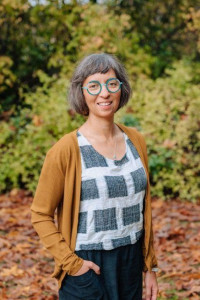Award Winner for Volume 17

Gift Economy in Art Museum Education: Imagining a Giving Museum
Unlike capitalist economy, which is grounded in independence, ownership, and excess, gift economy is steeped in relationships, generosity, interdependence, and gratitude. These qualities of gift economy can be powerful tools in efforts to transform museums into inclusive, caring, and dynamic locations for community engagement. In this article, an artwork exhibited in a university art gallery and an associated educational program designed to promote gift economy are explored. Directly in the exhibition space, diverse visitors engaged in art-making processes, connecting with a local community organization through gift giving. Engaging with ideas associated with gift economy during the art program, the gallery transformed into a site for creation, critical conversations, and giving. Using observations, questionnaires, and a self-reflection process, a study was conducted to explore what happens when we shift away from capitalist thinking in museums and how art and art museum education programming can support this transformation. This article explores how museums can incorporate concepts associated with gift economy into their programming and some of the ways in which such programming can stimulate and support a shift toward more caring, loving, relational, and empathic museums.
At this time of significant social division and strife, museums have the potential to become locations for healing, care, and relationality. This article radically re-imagines museums as moving away from capitalist ideologies and towards gift economy principles, which can support these more loving, empathic orientations. Steeped in relational potential, contemporary art and art education are situated as offering creative and potentially caring pathways for museums.
Through a focus on gift economy principles, this article has enhanced conversations associated with care ethics in museum education and art education. Additionally, through the in-depth examination of an artwork and art education program, the article highlights the potential roles contemporary art, artistic research, and culturally responsive pedagogy can play in empathy-centered work in art museum education. The paper offers practical methods for incorporating gift economy principles into the daily workings of museums. Through specific examples and practical applications, the article provides suggestions that can support museum professionals in their efforts to infuse gift economy principles into their practices. This combines theoretical discussions with action-oriented ideas associated with infusing relationality, reciprocity, and care into museum work. With this, the article contributes to the disruption of the cold, distant, capitalist-oriented historical practices of museums by envisioning an empathic, giving museum and providing strategies for implementing this vision.
As a result of this article, gift economy, reciprocity, and care ethics are even more central to my practices. This article is directly influencing my current research into anti-racist and anti-oppressive artist residencies in gallery settings and resulting curricular and pedagogical implications. Following this article, gift economy principles have become more prominent in my artistic practices, teaching, and artistic research. Furthermore, the ideas at the center of the article are guiding my burgeoning interest in eco-justice pedagogy. It is my belief that the care- and reciprocity-based orientations at the center of this article are needed in museums and art museum education now more than ever. Through such practices, museums have the potential to become central hubs for community care, reciprocity, and healing during these tumultuous times.
—Natasha Reid